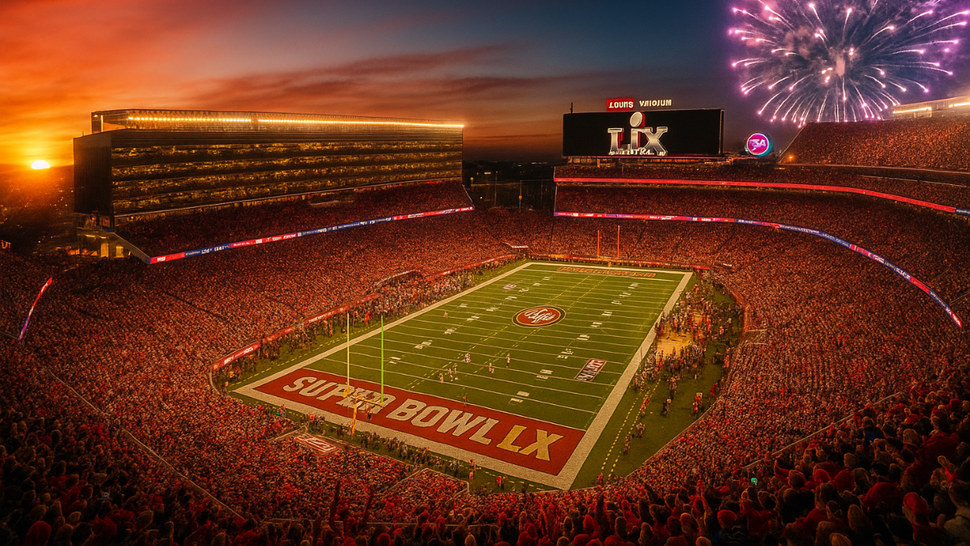By Mauricio Segura July 5, 2025

Photo: GBT Graphics
Levi’s Stadium is getting a major glow-up and it’s not just fans who are excited. The Santa Clara venue, home of the 49ers since 2014, is undergoing a sleek 200 million dollar renovation to ensure it shines at the center of two of sport’s biggest spectacles: Super Bowl LX and the 2026 FIFA World Cup. Despite being only 11 years old, the refresh shows just how fast stadium technology and expectations evolve.
The centerpiece of the upgrade? Astounding video boards. Levi’s will debut the largest outdoor 4K screens in the NFL, designed to draw eyes and enhance the in-game spectacle. That’s just the beginning. Alongside, the LED ribbon boards and lighting system are getting a serious boost with crisper visuals, punchier colors, and an elevated audiovisual punch.
Underneath it all, the field is getting a complete overhaul. The new turf system is designed to meet FIFA standards with advanced drainage and ventilation features. That matters now more than ever. The stadium is prepping not just for the NFL season but also the Concacaf Gold Cup this summer and the global roar of the 2026 World Cup.
When Levi’s Stadium first opened its gates in July 2014, it cost roughly 1.3 billion dollars to build, an amount typical for modern NFL palaces. But fast forward a decade, and stadiums like SoFi and Allegiant have gone all in on luxury and technology, pushing costs even higher. To stay on par with those trendsetters, Levi’s is essentially getting a tech facelift.
Over the years, the stadium has earned praise for its environmental design. It’s the country’s first newly built NFL stadium to achieve LEED Gold certification and features a rooftop farm, solar panels, recycled water systems, and other green initiatives. But while its environmental credentials are impressive, reception to the fan experience has been mixed. Many fans have described the atmosphere as too corporate, lacking the soul and spontaneous energy once found at Candlestick Park.
Critics have also pointed to turf issues, including slips in key games and challenging conditions for heat-exposed fans, particularly in early-season afternoon matchups. Even pilots flying into San Jose have noted the brightness of the scoreboard lights interfering with flights. It seems the embrace of new tech is both a blessing and a headache.
Yet now, as Levi’s Stadium braces for the global spotlight, the 49ers are making a clear bet: invest heavily now to shine later. The renovations set the stage not just for gridiron glory during Super Bowl LX in February 2026, but for the international football festival the stadium will host during next summer’s World Cup.
That World Cup spotlight brings its own drama. The Bay Area is shouldering as much as a 50 million dollar bill to host six World Cup matches, including security, policing, and city expenses, with the 49ers promising to cover a projected 37 million dollar shortfall. The deal narrowly passed through a Santa Clara City Council vote that exposed underlying tension over city funding rules and transparency.
In short, the 49ers are doubling down on their commitment to sports entertainment. They’re willing to pour in big bucks, now to modernize the stadium, and in the future to ensure major events land comfortably on the field. But this high-stakes play is balancing on a tightrope. Taxpayers, transparency, and public trust all hang in the balance.
So what does this all mean for fans? Picture this. Next season, your ticket gets you into a stadium that beams with visual fireworks. Gigantic 4K screens, sleek LED lighting, and lush green turf await. Behind the scenes, the roster of major events is stacking up. Concacaf Gold Cup, World Cup matches, and Super Bowl LX. For Santa Clara and the Golden Bay, that’s a whirlwind of excitement and scrutiny. Will this investment pay off in long-term prestige? Or will the glare drown out the genuine spirit 49ers fans crave?
As Levi’s Stadium turns another page in its story, it's clear the 49ers are playing for keeps not only on the field but in the broader business of being a premier sports destination. Whether you’re a casual fan or a die-hard season ticketholder, the next few years promise to be nothing short of captivating, if not entirely foolproof.















